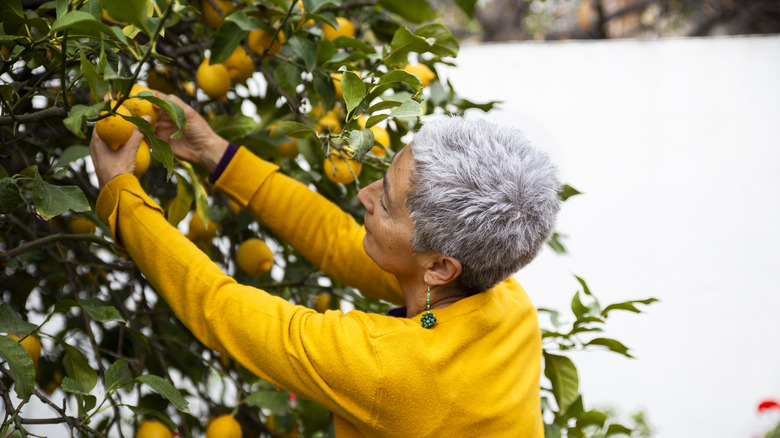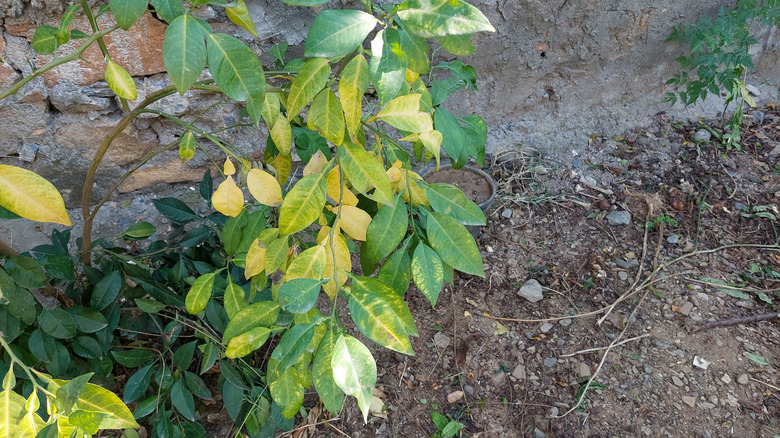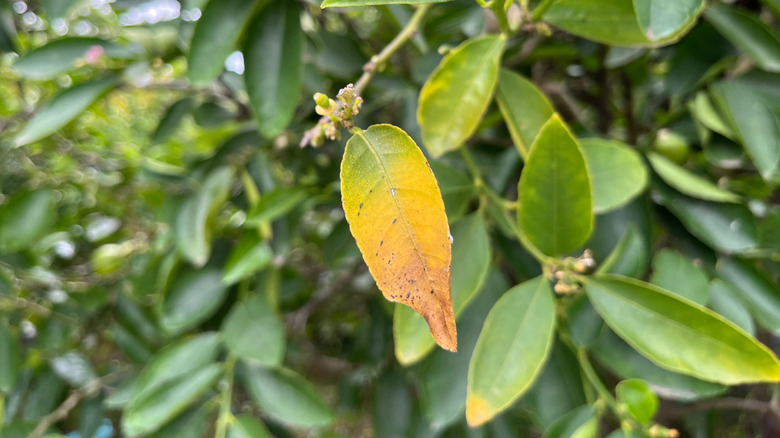How To Rescue A Struggling Citrus Tree Without Starting Over
If your citrus tree looks like it's struggling, you might feel like years of tree care are about to be lost. But diagnosing and fixing the problem can help you nurse your tree back to health. Many of the most common issues among citrus trees are related to excess water. It can leach nutrients from the soil and damage roots, making them less capable of taking up nutrients. So, regardless of symptoms, your first step should be to check your watering method.
Established trees need to dry out in between watering. Stick your finger into the top 3 to 6 inches of soil near your tree. If it's moist, don't water. If it's dry, apply 4 to 6 inches of water. If you're not sure how much that is, learn some essential measurements for watering plants deeply to make sure you're watering correctly. Aside from watering correctly, check soil drainage. If water pools even after a light rain or pools last for more than a day, immediate fixes include grading the soil around your tree so that water runs away from the trunk or installing a French drain around the roots.
For less serious drainage issues, apply compost on top of the soil around your tree every year. Planting ground cover, especially a nitrogen-fixing species like prairie clover or bush clover, around your tree can also improve soil drainage. If you know you're watering correctly and your soil has proper drainage, but your citrus tree is still struggling, use the following tips to fix other common problems.
Tips for rescuing a citrus tree with nutrient deficiencies
One of the most common citrus tree problems gardeners face with citrus trees are nutrient deficiencies. Citrus trees are heavy feeders, but before you reach for the fertilizer, it's important to understand what nutrients your tree needs — as well as whether another issue is preventing your tree from accessing the nutrients it needs. If new leaves look fine, but older leaves are turning yellow, it's likely a nitrogen deficiency. Trees tend to pull nitrogen from older leaves to feed younger leaves when they're not getting enough from the soil.
But, if older leaves look fine while new leaves are yellowing, it's more likely a deficiency of another nutrient like zinc, iron, or manganese. Before leaping to fertilizer, check other issues. Cold soil can slow down nutrient uptake, for example, so if you applied mulch in early spring when the weather was still cooler, you might have prevented the soil from warming up. Scrape the mulch to the side for a while so that the soil can warm up.
Another overlooked tip that'll help your fruit trees grow faster is getting rid of the grass near their roots. While ground cover can help improve soil drainage and nutrient availability, the dense root system of grasses blocks moisture and nutrients from reaching the tree roots below. So if you've been following the appropriate fertilizing schedule, but your tree still shows signs of nutrient deficiency, your lawn might be the culprit.
How to deal with other common citrus problems
Aside from nutrient deficiencies, it's easy for over-eager gardeners to end up applying too much fertilizer, which can cause problems of its own. If the trees' leaves are green, but the tips are yellow, over-fertilization is likely the cause. To fix it, stop fertilizing and help leach the excess nutrients from the soil by watering deeply when it's time to water (but don't increase the frequency of watering). If the leaves are yellow but the veins are green, it may be an iron deficiency triggered by a nutrient imbalance from excess fertilizer. In this case, stop using synthetic fertilizer and switch to a slow-release organic fertilizer.
Another issue that worries gardeners is fruit drop. Trees drop a lot of fruit a few weeks after the fruit sets as a way of balancing the amount of fruit it's producing with the amount of leaves it has to absorb energy. But if your tree is dropping more fruit than usual or dropping larger, older fruits, it might be a sign of stress.
Possible stressors to check for are excess heat or cold, sudden temperature changes, lack of water, or lack of nutrients. While there's little you can do about the weather, you can correct water or nutrient issues. Just be careful not to overcorrect by giving your tree excess water or fertilizer. To do that, follow the watering tips mentioned earlier and opt for slow-release organic fertilizers for a more balanced release of nutrients that are less likely to leach out of the soil.


